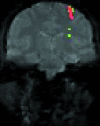Brain imaging: the NMR revolution. Interview by Clare Thompson
- PMID: 10559054
- PMCID: PMC1129079
- DOI: 10.1136/bmj.319.7220.1302
Brain imaging: the NMR revolution. Interview by Clare Thompson
Figures



Similar articles
-
Brain imaging in psychiatry: what has it done for the patient?Hosp Med. 2002 Jun;63(6):326-7. doi: 10.12968/hosp.2002.63.6.2000. Hosp Med. 2002. PMID: 12096659 No abstract available.
-
[Functional brain imaging in psychiatry].Duodecim. 2000;116(4):409-15. Duodecim. 2000. PMID: 11787093 Review. Finnish. No abstract available.
-
Clinical applications of neuroimaging in psychiatry.Magn Reson Imaging Clin N Am. 1998 Feb;6(1):155-64. Magn Reson Imaging Clin N Am. 1998. PMID: 9449746 Review.
-
Pretherapeutic functional magnetic resonance imaging in children.Neuroimaging Clin N Am. 2014 Nov;24(4):639-53. doi: 10.1016/j.nic.2014.07.002. Epub 2014 Nov 1. Neuroimaging Clin N Am. 2014. PMID: 25441505 Review.
-
Very like a fish.BMJ. 2011 Aug 3;343:d4918. doi: 10.1136/bmj.d4918. BMJ. 2011. PMID: 21816746 No abstract available.
Cited by
-
Purinergic system dysfunction in mood disorders: a key target for developing improved therapeutics.Prog Neuropsychopharmacol Biol Psychiatry. 2015 Mar 3;57:117-31. doi: 10.1016/j.pnpbp.2014.10.016. Epub 2014 Nov 7. Prog Neuropsychopharmacol Biol Psychiatry. 2015. PMID: 25445063 Free PMC article.
References
-
- Stark DD, Bradley WG. Magnetic resonance imaging. St Louis: Mosby; 1992.
-
- Grant DM, Harris RK. Encyclopedia of NMR. Chichester: Wiley; 1996.
-
- Budinger TF. MR safety: past, present, and future from a historical perspective. Magn Reson Imaging Clin North Am. 1998;6:701–714. - PubMed
-
- Le Bihan D. Diffusion and perfusion magnetic resonance imaging: applications to functional MRI. New York: Raven; 1995.
-
- Warach S, Gaa J, Siewert B, Wielopolski P, Edelman RR. Acute human stroke studied by whole brain echo planar diffusion-weighted magnetic resonance imaging. Ann Neurol. 1995;37:231–241. - PubMed
Publication types
MeSH terms
Grants and funding
LinkOut - more resources
Full Text Sources
Medical
